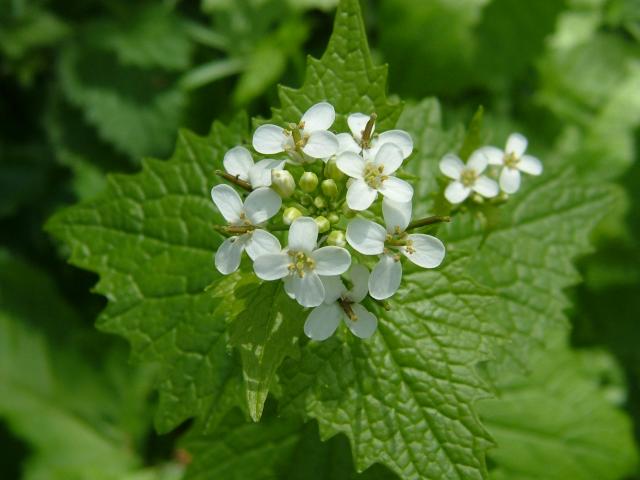
Second year plants have terminal clusters of flowers. Photo by APhotoFlora
Gather Garlic Mustard now for pesto or it may disappear presto… well… maybe not immediately but if one university succeeds Garlic Mustard will become hard to find or extinct in North America.
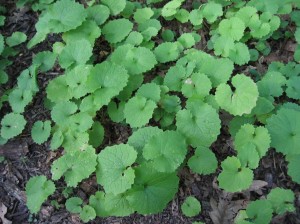
First-year plants are short with kidney-shaped leaves in a rosette. Photo by Field Botany
It all started on this continent sometime around 1868 when Garlic Mustard, a native of Europe, was found on Long Island, no doubt brought over before then for food and medicine. It’s leaves are rich in vitamin C and A and medicinally was used for treating gangrene and ulcers. Garlic Mustard spread slowly across the country reaching Oregon by 1959. It wasn’t a severe problem until about 40 years ago. Then it began to proliferate alarmingly. It went from taking over an estimated 366 square kilometers a year to 6,400. In the last four decades it’s become a significant pest, a dreaded “invasive.” Why? My guess is deer. The deer population has also dramatically increased in numbers during the same for decades. They prefer to eat native plants rather than Garlic Mustard. However, if you have more deer eating the native plants to the ground it gives prolific Garlic Mustard chance and space to get going. Once it does it drives out other plants including trees.
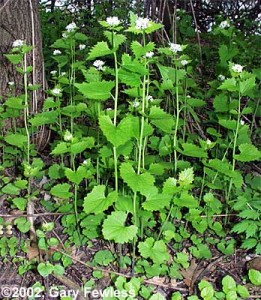
Second-year plants grow rapidly tall and flower. Photo by Gary Fewless.
Garlic Mustard can produce up to 8,000 seeds per plant. That can translate into 100,000 seeds per square meter which are easily spread around. Germination rate is close to 100% and up to 24,000 seedlings per square meter have been counted. The seeds can remain viable for up to 10 years. Most of the seeds don’t survive but it’s a numbers game and Garlic Mustard is simply out-breeding its competitors. Shade tolerant, the species is found in southern Canada and 34 US states where it’s officially invasive in six. In western Europe is ranges from Italy to Sweden, England to Russia and parts of Asia. Garlic Mustard basically skips the southern United States among other reasons because the seeds need long exposure to cold to reproduce, sometimes as much as one or two winters. However, seeds can germinate right at 32 F giving it a jump over other spring-time plants. Second year plants bolt very quickly.
Regardless of why Garlic Mustard is proliferating it is considered a serious invasive species in North America. But have little fear, the University of Minnesota is coming to the rescue. Starting in the 90s experts began looking for a biological control. Several insect candidates were considered. The university has decided thus far the leading contender is Ceutorhynchus scrobicollis, a weevil of a beetle from Europe. If approved the insect will be released between now and 2016. The goal? Wipe out this foreign invader that also has cyanide in it’s leaves. What? Cyanide? Yep, and those who demonize this wild edible are quick to point that out. So what about the cyanide?
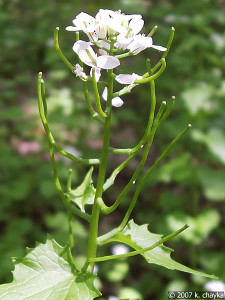
Like many members of the Mustard family the species has long, skinny seed pods. Photo by K. Chayka
It’s not that uncommon in the Brassicaceaes. The cyanide is usually minimal and below that to impact animals or people. However it is enough to be toxic to some fungi, pathogens and insects. It can be a killer if you have six legs. That also might be how it keeps other plants from growing where it grows by killing off necessary soil bacteria and the like. The level of cyanide is not a threat to people. Garlic Mustard did not earn a mention in Poisonous Plants of the United States and Canada by Kingbury, for many decades if not still the “bible” on poisonous plants. (See the Herb Blurb below the recipe.)
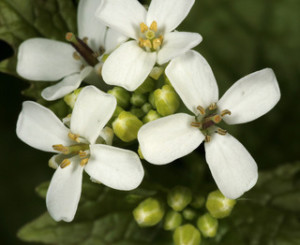
Like all mustards the flower has six stamens, four long and two shot best seen in the top flower. Photo by Les Mehrhoff
A two-year plant, Garlic Mustard grows rapidly in the spring producing a basal rosette. During its second year it can reach one or two yards high. It is usually the tallest bloom plant in the forest around May. Also called Jack-By-The-Hedge and “Sauce Alone” the leaves taste like garlic and mustard with a slightly bitter aftertaste. The leaves smell of mustard when crushed and stems are often purplish. The first-year rosette has kidney-shaped toothy leaves. They can remain green through the winter. Second-year toothy leaves are more triangle shaped along a tall flowering stem. Seed pods are shiny black when mature. Plants that grow near Garlic Mustard and might be confused for it are Toothworts (Dentaria) Sweet Cicely (Osmorhize claytonii) and early saxifrage (Saxifraga virginica.)
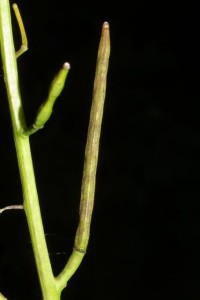
Small brown-black seeds aline in the “silique.” Photo by Steve Baskauf
Botanically the species is Alliaria petiolata. Alliariea is a variation of Allium, the genus for garlic and onions. It is from the Greek word αλέω which means “to avoid” presumably because of the garlic/onion aroma. Petiolata is from Dead Latin: petiolatus “petiolate”, referring to leaf attachment. “Jack” by the way when referring to plants usually means the Devil.
If you do go through a patch of Garlic Mustard clean your shoes and any pants’s cuffs to keep you from taking home this species that can easily take over your yard. Of course, eating the invasive is your civic duty and tasty, too.
Green Deane’s Itemimized Plant Profile: Garlic Mustard
IDENTIFICATION: Alliaria petiolata: Biennial herb with a weak single stems 12 – 36″ high its second year. Leaves: Round, scallop-edged, dark green; first year, rosettes of three or four leaves; second year plants have alternate stem leaves. Leaves and stems smell like onion or garlic when crushed. Flowers: White, small, numerous, four separate petals. One or two flowering stems on second year plants. Seeds: Slender capsules to six inches long with a single row of oblong black seeds, 12 to 19 seeds per pod. White, slender taproot, S-shaped at the top. The root smells like horseradish.
TIME OF YEAR: Growing by March or April. Two-year cycle, low rosette the first year, tall and flowering the second. Grows very rapidly in spring.
ENVIRONMENT: Moist, shaded soil; river floodplains, forests, roadsides, edges of woods, trails edges, forest openings, disturbed areas. Does not tolerate highly-acidic soil and prefers to not grow under conifers. Often found in association with hardwoods.
METHOD OF PREPARATION: Garlic Mustard is usually used raw. Second-year shoots before blossoming are choice. British naturalist Richard Mabey says the best use is as a sauce for lamb. Merritt Fernald, the grand botanist of Harvard a century ago, reported it was used like a lettuce leaf but for flavoring in sandwiches, mixed in salads, eaten with salted fish and used as a stuffing in pork. Cornucopia II says the leaves can be finely chopped and added to tossed salads, cooked as a pot herb, or eaten with bread and butter. It is also mixed with mint leaves and made into a sauce for salt-fish, mutton, and as mentioned before, lamb. Ray Mears reports the leaves are good added to nettle soup and the seeds make a very fiery mustard. Pick the leaves just before you want to use them. They wilt quickly.
The following recipe was created by Paul Wedgwood of Wedgwood the Restaurant, one of Edinburgh’s finest and originally reported by Robin Harford on a British website with a name very close to this one, www.EatWeeds.com.Uk.
Garlic Mustard Vichysoisse
Ingredients
• 75g butter
• 1 onion, chopped
• 75g three cornered garlic stems
• 800 ml water
• 1 large potato, peeled, diced and rinsed
• Salt and freshly ground black pepper
• 75g Jack by the hedge/garlic mustard
• 75g goat’s cheese
• 75ml milk for foam
• Pinch cumin
• Pinch white pepper
Suggested Instructions
1. In a heavy bottomed pan add water and potatoes and a good pinch of salt and boil until potatoes are soft. Remove from the heat and set aside.
2. Melt the butter in a medium saucepan. Add the onion and cook until softened. Pour over the boiled potatoes and water.
3. Blitz in food processor until smooth. Add water if required to the correct consistency. Pass through a sieve.
4. Chill in the fridge. Check seasoning.
5. Blanch jack by the hedge for 10 seconds in salted boiling water and refresh in ice water.
6. Add jack by the hedge and blitz again until smooth.
7. Then add the three cornered garlic blitz until smooth, check for seasoning again.
8. Serve with some crumbled goats cheese, frothed milk, a pinch of cumin, some crispy fried nettle dusted with white pepper and a three corned garlic flower
Prep time: 30 mins.
Cooking time: 10 mins.
Serves: 4
Herb Blurb
J Chem Ecol. 2007 Jan;33(1):85-94.
Cyanide in the chemical arsenal of garlic mustard, Alliaria petiolata.
Cipollini D, Gruner B. Source: Department of Biological Sciences, Wright State University, 3640 Colonel Glenn Highway, Dayton, Ohio 45435, USA. don.cipollini@wright.edu
Abstract
Cyanide production has been reported from over 2500 plant species, including some members of the Brassicaceae. We report that the important invasive plant, Alliaria petiolata, produces levels of cyanide in its tissues that can reach 100 ppm fresh weight (FW), a level considered toxic to many vertebrates. In a comparative study, levels of cyanide in leaves of young first-year plants were 25 times higher than in leaves of young Arabidopsis thaliana plants and over 150 times higher than in leaves of young Brassica kaber, B. rapa, and B. napus. In first-year plants, cyanide levels were highest in young leaves of seedlings and declined with leaf age on individual plants. Leaves of young plants infested with green peach aphids (Myzus persicae) produced just over half as much cyanide as leaves of healthy plants, suggesting that aphid feeding led to loss of cyanide from intact tissues before analysis, or that aphid feeding inhibited cyanide precursor production. In a developmental study, levels of cyanide in the youngest and oldest leaf of young garlic mustard plants were four times lower than in the youngest and oldest leaf of young Sorghum sudanense (cv. Cadan 97) plants, but cyanide levels did not decline in these leaves with plant age as in S. sudanense. Different populations of garlic mustard varied moderately in the constitutive and inducible expression of cyanide in leaves, but no populations studied were acyanogenic. Although cyanide production could result from breakdown products of glucosinolates, no cyanide was detected in vitro from decomposition of sinigrin, the major glucosinolate of garlic mustard. These studies indicate that cyanide produced from an as yet unidentified cyanogenic compound is a part of the battery of chemical defenses expressed by garlic mustard.
PMID:
17146719
[PubMed – indexed for MEDLINE]

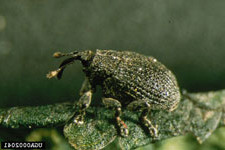
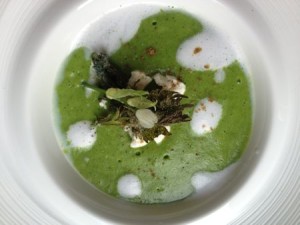

Nice article, as always. I work at Mammoth Cave in KY and that was the first place I ever heard of this plant, they have a strong push to eliminate invasive plants too. Since hearing of it, I see it everywhere. Interesting to note that if trends continue here weatherwise, the plant will be eliminated without help from us. My son has taken the battle against invasives to heart and when he found a of garlic mustard on our place last week he made us a pot of potato soup with garlic mustard! One recommendation, be sure to remove all stems, they do not cook well even with quite a bit of boiling. We were constantly picking them out while eating the soup.
Hopefully we won’t have a weevil problem after the suggested solution is put into action. Love the taste of the plant and it does grow everywhere!
Plenty here in Connecticut. I’ve been pulling them by the roots and adding as green manure to the compost heap. My comfrey will soon become the dominant “invasive” species, eh!
The problem with composting garlic mustard is that the seed pods will continue to develop even after the plant has been pulled out by the roots. When groups go in to try reducing it in an area, all pulled plants are carried out.
We mass the pulled stems in piles. The piles don’t go anywhere. If seeds develop and sprout they’ll be easy to smother. So far, that has worked. It’s not ideal, but simpler than other disposal options. We also try to pull as much of it as possible before seed development begins.
We literally have acres of it. It’s a very invasive plant. It creates colonies and takes over from there. The tiny seeds are easily picked up in the treads of shoes, tires and spread to new locations. Many of the animals around here won’t eat it. I just thought I’d give a heads up on that if anyone considered trying to grow it deliberately. We’re doing what we can to rip it out as it’s displacing plants the wildlife need.
If you are going to consume this plant- first make yourself aware of the symptoms of cyanide poisoning.
I got sick from eating it and I cooked it. I can’t have tapioca either, even the quick dry kind. I guess some people are especially sensitive to cyanide.
The roots in late fall and early spring are also a very good horseradish condiment. If its not you didn’t use the tender part of the root that snaps off easily or you picked it too late. I preserve in vinegar in the fridge and have quickly gone through a quart. So its not just an herb.
cyanide poisoning??
Be aware that a small percentage of the population has a reaction to the plant oils. Unfortunately I am one of them and I break out with a rash similar to poison ivy just brushing up against it.
Thank you for the information you shared today. I found your presentation to be very informative and entertaining. I was the old guy that had to leave early at the Saturday class. I consider the money well spent and will recommend others to attend your presentations in the future. I would like to bring my grandson the next time. I think the generation coming up will be well served by this information that by and large has been forgotten.
Thanks… it was a large class but it worked out will. Glad you attend, hope to see you again.
Greetings
The garlic mustard is pulling up so easily after all of the rain we’ve had, I have wondered if the root is edible. JamesM writes that he preserves the young roots in vinegar. You say nothing really about the roots. Would it be the early second year root or the first year root (from the Fall?) – maybe that’s the same thing. Thoughts?
Heather, on the Green Deane Forum, had this reply: “Second year roots will be spicier, but the most important thing is that they are taken in either the spring or the fall when there are no flower stalks. They have a horseradishy flavor.”
Thanks, Heather!
Roots can be turned into horseradish! And seeds into mustard, but better to not let it go seed
I’m curious as to why you say the cyanide content is usually low and below that needed to impact humans. The study you quote at the end of the post says it is actually quite high, far higher than that of other brassicas. On what are you basing your statement that it is too low to impact humans?
Because while it might be high for a Brassica it does not rise to the level of being a problem, kind of like arsenic in loquats.
But it says in the article that the cyanide level in garlic mustard is generally considered “toxic to many vertebrates”. Is it much higher than the cyanide levels in other foods we typically eat? Is this a plant that should come with a caution to consume it in very small amounts? If so, how much is safe.
No, it is small amounts and those are small vertebrates… Onion can kill you if you eat enough of them. Consider oxalic acid found in sorrel. It is what gives the plant its tart taste. Is it toxic? Yes. But you’d have to eat 12 pounds or so at one time to get close to the median lethal dose.
I did read that the trace amounts of cyanide are not enough for most to react to. However, it greatly effects certain fungi, pathogens and insects.
https://plighttofreedom.com/garlic-mustard/
The claim that this plant is safe for human consumption is wrong. I tried to eat it for a few days and I definitely got sick. It’s not my imagination either.
Maybe it’s because the garlic mustard plants in my area are fresh invaders. All I know is that I’m disappointed because I liked the taste.
I am sensitive to cyanide. I can’t eat tapioca anymore because of it. I bought dry quick tapioca (store brand) and got sick from eating that, too. Clearly, I am an example of at least one human out there who can’t consume garlic mustard in a significant quantity.
Cyanide is reduced greatly by blanching or soaking. Drain the water and rinse thoroughly; using a colander should make this easy. Just soaking it won’t remove nutrition, but the toxins are readily water soluble
I would like to preserve and eat Jack by the Hedge as it is growing in my garden. If I soak it in an effort to remove the toxins, and then dry it and chop it up and store it in an airtight container, will it be ok to eat or will I be concentrating the toxins that are left and will this make it unsafe to eat?
Thank you for an informative website, I have only just found it.
Regards
Hils
Hils,
That process will not render it any more concentrated than before, as far as I can tell. As long as you’re not consuming multiple pounds of the stuff in one sitting!
Four years later, hope this helps.
any ideas on consuming Sedum? a stone crop.